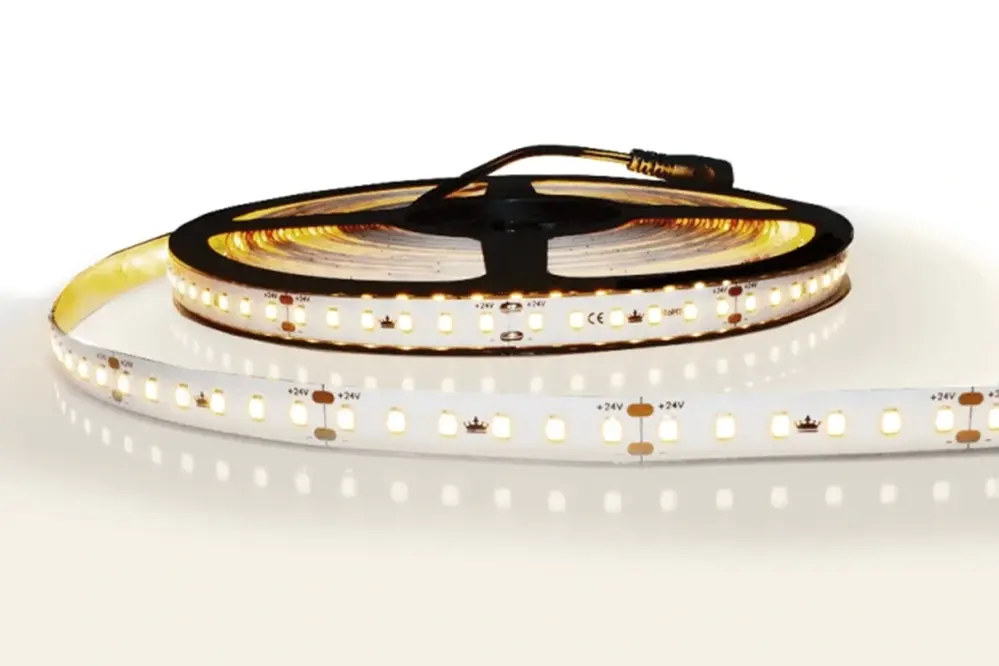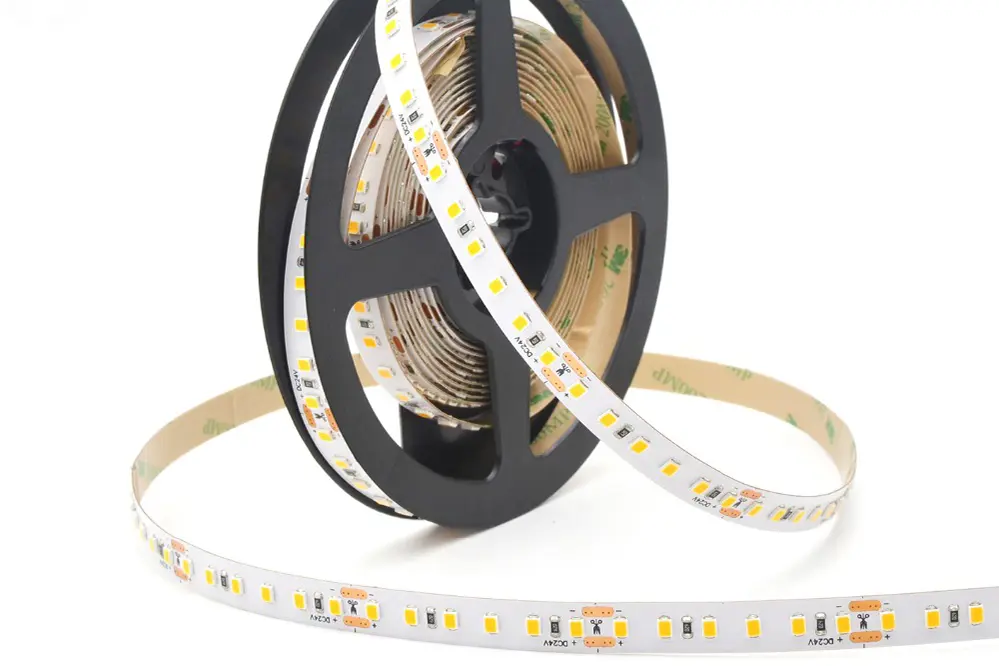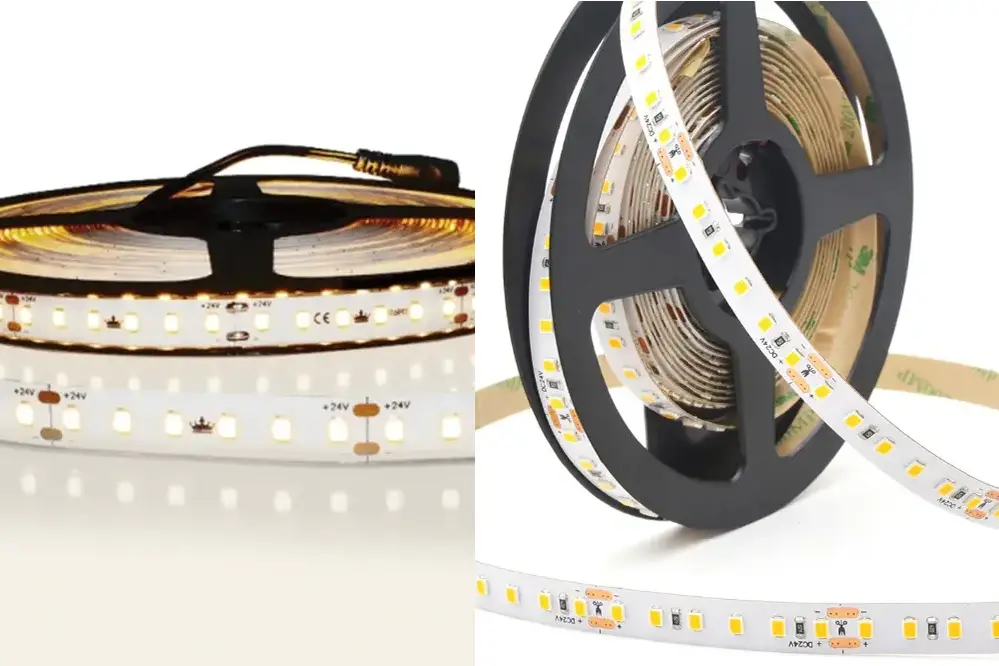Imagine walking into a room, where the lighting is perfectly balanced, thanks to advanced led drivers, providing a comfortable and inviting ambiance. Such precision in lighting design is often achieved through careful selection of LED strips with unique characteristics that rely on either direct current or alternating current.
LED strips generally come in two types: constant current and constant voltage.
Deciding between constant current vs constant voltage LED strip options can significantly impact the quality and efficiency of lighting in any space, whether it’s a home, office, or commercial environment.
Understanding Constant Current LED Strips

Constant current LED strips are designed to maintain a steady current throughout the strip, often requiring specific led drivers for optimal performance. Without a suitable led driver, the efficiency and lifespan of the strips could be compromised.
This approach ensures the LEDs receive a consistent amount of power, safeguarding them against variations and preventing thermal runaway. Constant current strips are particularly suited for applications where even illumination is critical, eliminating the risk of hot spots or dimmed sections that might arise from variable power supplies and potential dimming issues.
Furthermore, these strips often have built-in circuitry that regulates the current flow. By managing this fundamental aspect, constant current LED strips can extend the lifespan of the LEDs and provide more reliable performance over an extended period, making them a robust choice for challenging environments.
In summary, constant current LED strips offer substantial advantages in stability and longevity, especially when paired with an efficient LED driver. Their compatibility with high-quality led drivers ensures they operate at peak efficiency and performance. This makes them an excellent option for precision-required scenarios, ensuring consistent light quality and reducing maintenance needs. Their built-in regulation and compatibility with high-quality led drivers simplify installation, offering a seamless solution to sophisticated lighting projects.
Understanding Constant Voltage LED Strips

Constant voltage LED strips offer distinct advantages.
These LED strips are designed to operate at a specific voltage, typically 12V or 24V. This makes them easier to work with, especially for DIY enthusiasts or projects requiring flexibility in terms of installation length. Furthermore, constant voltage technology allows users to cut and connect the strips at various points, tailoring the lighting to specific dimensions and shapes.
Ease of use is their primary attribute, and this is facilitated by the inclusion of diodes in their design.
One of the notable benefits of constant voltage LED strips is the simplicity of integrating multiple strips. By connecting them to a standardized voltage source, it becomes straightforward to expand or alter the lighting layout, thus catering to evolving needs and aesthetic preferences.
In addition, they are widely available and generally more cost-effective. Ideal for residential and commercial applications such as under-cabinet lights, accent walls, and signage, constant voltage LED strips provide versatile solutions without compromising on quality. Their adaptability makes them a favorite among both amateur and professional users, ensuring bright and consistent illumination for diverse settings.
Constant Current vs Constant Voltage: Key Differences
When it comes to LED lighting, constant current and constant voltage LED strips offer distinct advantages, each beneficial for different applications.
Constant current LED strips ensure consistent brightness.
This is achieved by regulating the current, allowing the LEDs to receive a steady amount of power, which reduces the risk of overheating and extends their lifespan.
On the other hand, constant voltage LED strips are designed to be more adaptable and user-friendly, particularly for projects requiring different installation lengths. They can be cut and connected easily, making them highly versatile for customizing lighting designs in various shapes and dimensions.
Efficiency and Performance Comparison
In evaluating efficiency and performance between constant current and constant voltage LED strips, one must consider several critical factors. Among these, energy consumption, light output consistency, and overall system longevity are paramount.
Constant current LED strips are known for their impressive energy efficiency. They ensure uniform power delivery throughout the strip, leading to consistent brightness levels.
Moreover, constant current designs minimize the risk of overheating. This results in an enhanced lifespan for the LEDs, making them a cost-effective solution over time.
On the contrary, constant voltage LED strips offer remarkable flexibility. They are easily customizable and can be cut and connected without compromising performance, ideal for varied installations.
However, this versatility can sometimes come at the cost of efficiency. Voltage drop along the strip may cause slight variations in brightness, especially in longer installations.
Ultimately, the choice between constant current and constant voltage LED strips depends on the specific application requirements. Each offers unique advantages that can cater to diverse lighting needs with great efficacy.
Benefits of Constant Current LED Strips
Constant current LED strips provide remarkable benefits for various lighting applications. But what makes them so advantageous compared to their constant voltage counterparts?
Since 2016, lighting professionals have increasingly favored constant current LED strips for their superior performance, ensuring uniform brightness. Their consistent power delivery reduces the likelihood of hot spots.
Furthermore, it’s not just about brightness; constant current’s ability to mitigate overheating is crucial. This attribute extends the lifespan of the LED strips, presenting a sustainable and economically viable option.
Another key advantage is the high level of efficiency these strips offer, with a focus on precise energy consumption, ideal for large-scale lighting systems, and architectural projects requiring flawless illumination.
This efficiency combined with longevity makes constant current LED strips the preferred choice for many discerning professionals.
Benefits of Constant Voltage LED Strips
Constant voltage LED strips offer unique advantages that make them a compelling choice for various lighting projects, particularly for those requiring flexibility and ease of installation.
One significant benefit is their straightforward wiring process, which simplifies setup.
These LED strips connect directly to a power supply, making them ideal for DIY applications and quick installations.
With a constant voltage configuration, multiple strips can be connected in parallel, allowing for extensive coverage.
Additionally, constant voltage LED strips are highly compatible with different power sources, including batteries and solar panels.
This compatibility ensures that users can apply them in a vast array of environments and scenarios, from residential spaces to outdoor installations where reliable power might be an issue.
Overall, the ease of use and versatility of constant voltage LED strips make them an excellent option for diverse lighting needs.
Common Applications for Constant Current LED Strips

Constant current LED strips find prominent usage in applications where precision and uniformity of light output are paramount, ensuring consistent performance without fluctuations.
Retail and display lighting benefit greatly from these strips.
Due to their ability to maintain a steady brightness regardless of length variations, constant current LED strips are perfect for highlighting merchandise, creating captivating displays, and enhancing the shopping experience in retail environments.
Moreover, these strips are commonly employed in architectural lighting to emphasize the contours of buildings or rooms with consistent luminosity, adding a sophisticated touch to spaces. In professional settings, they are ideal for task lighting due to their reliable and focused light output, which not only enhances visibility but also reduces eye strain for prolonged activities.
Common Applications for Constant Voltage LED Strips

Constant voltage LED strips are well-suited for a variety of DIY projects and home lighting scenarios where ease of use is crucial.
For instance, in residential settings, they are a popular choice for under-cabinet lighting in kitchens, adding a modern aesthetic while illuminating workspaces. Additionally, homeowners often use them for accent lighting to highlight architectural features or to create an inviting ambiance in living rooms and bedrooms.
These strips are also ideal for decorative purposes in commercial spaces. In hospitality environments such as hotels and restaurants, they can be deployed to set a specific mood or theme, enhancing the overall atmosphere and customer experience.
Commercial signage and display cases benefit significantly from constant voltage LED strips as well. Their simplicity and flexibility allow for easy customization, ensuring that businesses can effectively showcase their products and branding to attract customers, demonstrate professionalism, and create a memorable visual impact.
Installation Considerations
When comparing installation requirements, a constant voltage LED strip generally requires simpler wiring. Installers benefit from straightforward connections to power sources without extensive configuration. On the other hand, installing a constant current LED strip might necessitate additional expertise due to specific driver requirements. However, these requirements can be offset by the long-term benefits of consistent brightness and extended LED lifespan. Therefore, while initial installation may be more complex, the long-term operational efficiency speaks volumes for those who prioritize sustainability and lasting performance.
Wiring Complexity
Constant voltage LED strips are easier to install, reducing the need for intricate configurations, which can save time. Their simplicity makes them ideal for beginners and small projects.
Conversely, constant current LED strips necessitate intricate wiring and specific drivers, ensuring even brightness. This complexity can deter beginners but offers more consistent performance over time.
Increased wiring complexity can enhance the lifespan and brightness uniformity of LEDs.
Overall, the choice hinges on the project’s scope and expertise levels. Beginners may prefer constant voltage strips for ease of use, while professionals might choose constant current strips to guarantee optimal performance and longevity. Understanding wiring complexity is vital to achieving desired lighting outcomes.
Power Supply Requirements
Constant current LED strips demand power supplies that deliver a consistent current flow, ensuring efficient performance. They require dedicated constant current drivers.
These drivers regulate the current and ensure a uniform light output.
Conversely, constant voltage LED strips utilize power supplies maintaining stable voltage levels. This allows them to be more flexible in terms of design.
Voltage variability can affect performance, making the choice of power supply crucial for project success. These strips typically use standard, off-the-shelf power adapters.
Choosing the appropriate power supply is paramount for maximizing the LED strip’s efficiency. This decision can impact everything from installation ease to long-term operational costs.
Ultimately, the specific requirements of the lighting project will determine the best power supply. Both types offer distinct advantages when paired correctly.
Cost Comparison
When comparing constant current vs constant voltage LED strips, cost becomes a pivotal factor.
In 2016, industry estimates showed that constant current LED strips commanded higher initial investments. This was largely due to their specialized power supplies and precision engineering requirements.
However, it’s not just about the upfront cost. Over time, constant current strips can prove more economical through superior energy efficiency. This can result in notable long-term savings on utility bills.
Despite the lower initial cost of constant voltage strips, they may not always offer the same operational longevity. These strips might require more frequent replacements and may exhibit reductions in performance over time, impacting maintenance costs.
Evaluating total cost involves considering both immediate expenditures and long-term benefits. Choosing wisely can ultimately enhance both efficiency and budget alignment.
Longevity and Durability
In the realm of longevity, LED strips that operate on constant current tend to have a distinct edge. They maintain a consistent light output and prevent overheating, thus extending their lifespan.
Constant current technology minimizes the wear and tear on LEDs, allowing them to function optimally over an extended period.
Consequently, these strips reduce the frequency of replacements, contributing to their overall durability.
On the other hand, constant voltage LED strips might suffer from voltage drops along lengthy runs, leading to uneven lighting and potential hotspot damage.
Such inconsistencies can accelerate the degradation of the LEDs, necessitating more frequent maintenance and replacements. Although initially less expensive, this can result in higher costs over time.
Ultimately, the choice hinges on one’s priorities regarding maintenance. Constant current strips offer a more dependable and enduring solution, ideal for those valuing long-term durability and consistent performance.
Which Is Better for Specific Lighting Needs?
The decision between constant current and constant voltage LED strips hinges on the precise lighting requirements and application.
For accent lighting or shorter runs, constant voltage LED strips provide an economical and simple solution, often selected based on their lumens rating to ensure desired brightness levels.
These strips are easier to install and are perfect for DIY projects where uniform brightness is not critical. Moreover, they accommodate varying lengths without needing complex calculations.
However, for applications demanding precise brightness and extended runs, constant current LED strips are unequivocally superior. These strips ensure consistent light output, optimizing for longevity and minimizing maintenance over large installations. Consequently, they are better suited for professional or high-expectation environments where performance cannot be compromised.
Expert Recommendations and Final Thoughts
Professionals in the lighting industry have long debated the merits of constant current vs constant voltage LED strips, each offering a distinct set of advantages.
The key is understanding the needs of a specific application.
For shorter, decorative installations, a constant voltage LED strip might meet and exceed expectations.
In professional or high-expectation environments, constant current LED strips often deliver the utmost performance.
Experts recommend pairing constant current LED strips with proper drivers to maximize efficiency and lifespan. For DIY enthusiasts, constant voltage options can offer a satisfying balance of simplicity and functionality.
Ultimately, the choice reflects one’s specific lighting needs. Investing in the right LED strip translates to enhanced lighting quality and satisfaction.
Conclusion
Selecting between constant current and constant voltage LED strips depends on your needs. Constant voltage strips are great for simple, short decorative installations due to their easy setup and balanced performance. On the other hand, constant current strips are better for professional applications, offering consistent performance and longer LED lifespan. Both types have their benefits, so understanding these differences helps you make an informed choice. Ultimately, choosing the right LED strip improves lighting quality and satisfaction by matching the strip to your project requirements.
For those seeking to make a more informed decision or looking for high-quality LED strips tailored to their specific needs, reaching out to experts is always a wise choice. Unitop, a renowned Chinese manufacturer of LED strip lights and LED neon strips, offers unparalleled expertise and a wide range of products to meet diverse requirements. With their professional insight and commitment to excellence, clients can expect superior solutions that perfectly align with their projects, ensuring optimal performance and lasting satisfaction. Contact Unitop to explore their innovative lighting solutions and elevate your lighting design to new heights.





